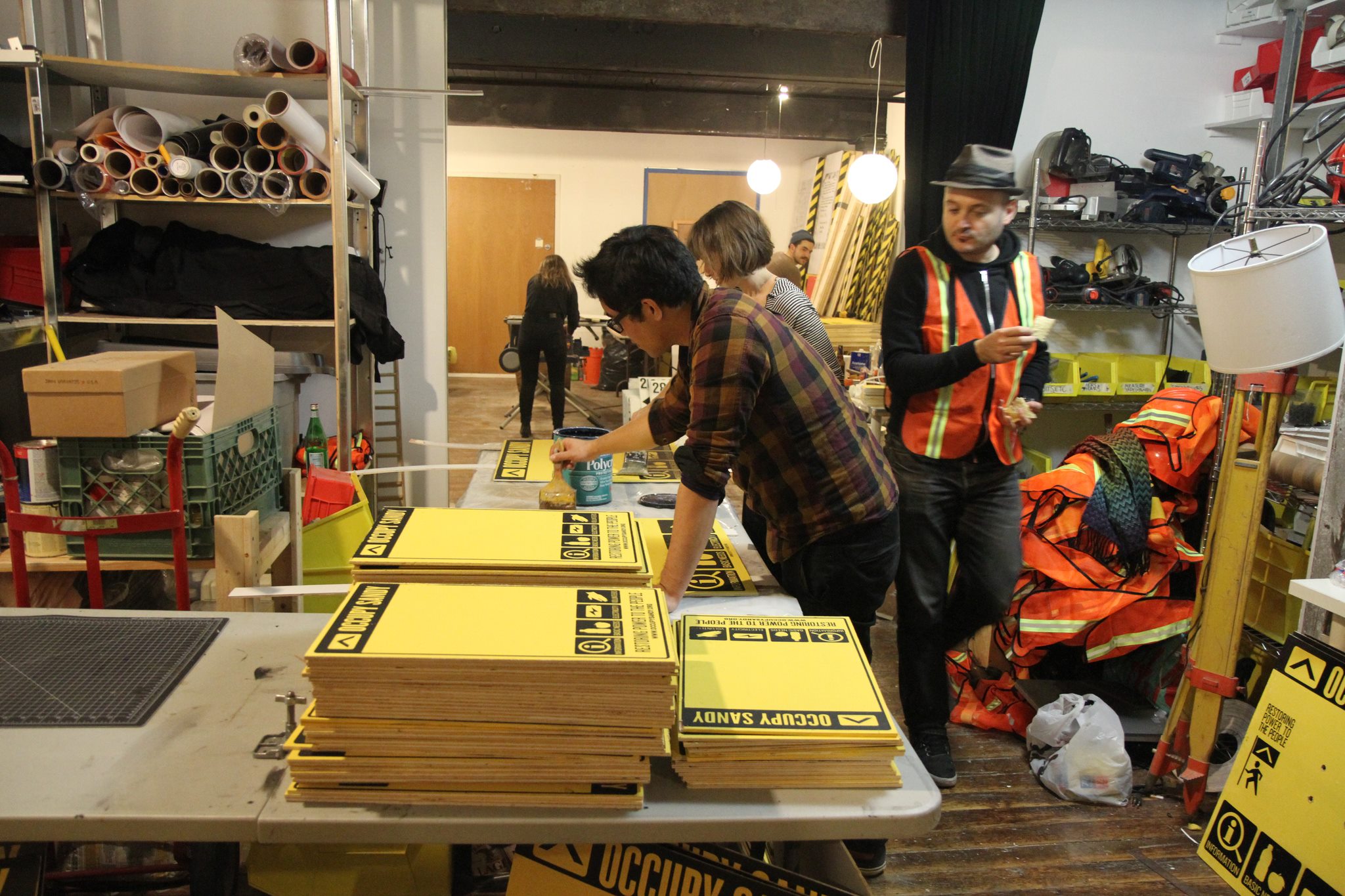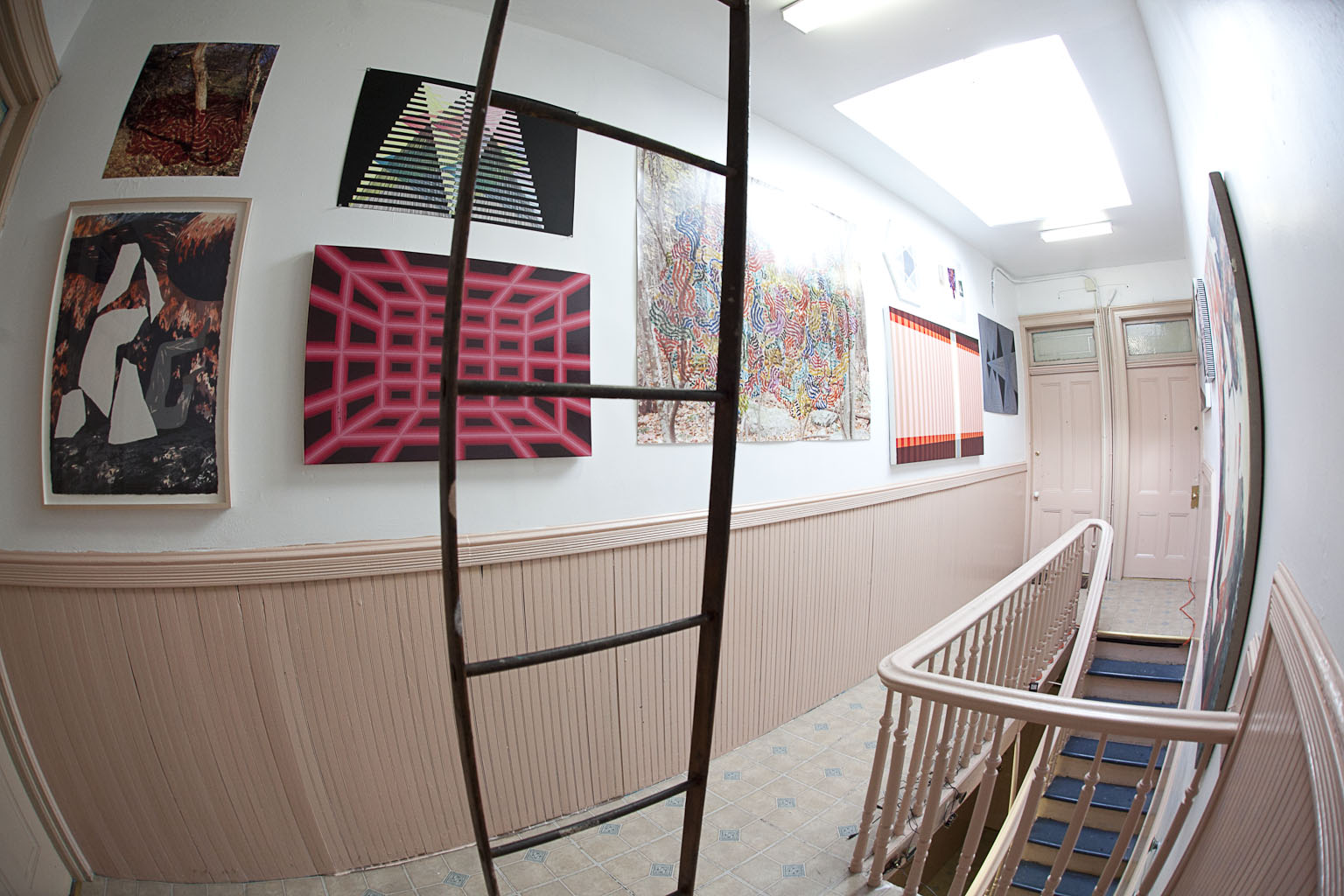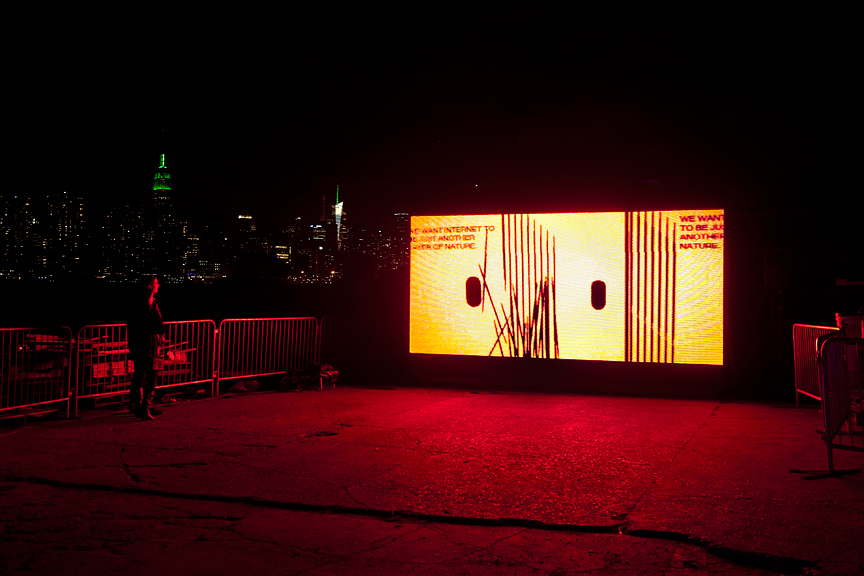no-space
space type: activism | neighborhood: greenpoint | active since: 2011 | links: website, facebook, twitter
No-Space is the current workshop for Not An Alternative, an art-and-activism collective that works to affect politics and culture through organizing, education, and partnering with community groups. The group is led by Beka, a progressive-nonprofit strategist, and Jason, an artist and video-production specialist. Not An Alternative’s old home, Change You Want to See Gallery, was an activism hub in Williamsburg in the mid 2000s, where the group hosted film screenings, lectures, workshops, and production meetings, as well as a rotating cast of collaborators, including the Yes Men, Reverend Billy, and members of the Barcelona activist collective Yomango.
The new space, in industrial Greenpoint, has coworking desks in the back and a production facility in the front. The group and the space have been very active in Occupy Wall Street, Occupy Sandy, and many other Occupy and activist permutations. A large part of NAA’s disaster-relief contribution has been designing and producing visual symbols for the movement, such as vests, magnets, patches, and “way-finding” signs, to clarify and make physical the incredible work that Occupy Sandy has been doing since the superstorm hit. This work has been done in conjunction with Occupy Town Square, Pratt’s Disaster Resilience Network, and the Wise City.
Not An Alternative is always seeking coconspirators and collaborators, so get in touch to join in with their work. But first check out my interview with Jason!
brooklyn spaces: How did Not An Alternative come about?
Jason: It was created in the lead-up to the Republican National Convention in 2004. People had realized that reenacting tactics they’d seen in the sixties wasn’t going to work, so we had to think of different ways to affect transformation. Our space became an organizing and production hub. Every week we would hold a production meeting for a different group, and we would connect them with curators or people with space or materials, and just sort of help the whole thing get under way. After the convention and the election, we realized that we’d created an important thing. We were trying to decide how to continue it, and the next thing we realized, our neighborhood was under this massive rezoning. So we jumped into that, because it was really all the same thing. This is politics, this is globalization on a local level.
brooklyn spaces: So it evolved into a general gathering spot and workspace for creative activism, which became the Change You Want to See Gallery.
Jason: Yeah. We started hosting events around the same things, activism and technology theory. So it was brainstorming, theory, discussion, presentations, and workshops, and then production—taking all those ideas and putting them into practice with community groups, social movements, different campaigns.
brooklyn spaces: Are there community groups or campaigns that were particularly inspiring to you, or that you felt really worked?
Jason: We did some work with Picture the Homeless that I think was really good, after the crisis of 2008. We partnered with them on an action where they put up a tent city in a vacant lot. We pretended to be a film crew: we drove in with forty people, set up one of those white tents with tables and bagels, and shot a fake music video while our “stagehands” were in the back cutting down the fence and setting up the tent city. By the time the police came, the whole thing was erected. It got great media attention, we even had a story in the New York Times. There was a lot of pressure on Bloomberg at that moment, because he had just announced the results of a five-year plan to end homelessness, which had ended in an abject failure.
brooklyn spaces: What were some great presentations or workshops?
Jason: There were so many. Reverend Billy did the closing of the space, which was great. We had a great series called “Symbols, Branding and Persuasion,” where we had designers, activists, and people involved in branding talk about their practices. We had a friend of Beka’s who basically led the design team for Obama, we had someone who ran focus groups, we had the creative director of Interbrand, which is the largest branding company in the world. Activists are largely very alienated by advertising, it kind of suggests manipulation, but we tried to break those things apart.
brooklyn spaces: And Change You Want to See Gallery ended right before Occupy Wall Street, right?
Jason: Yeah, just a month before. By the time we left we no longer made any sense in Williamsburg anymore. We were across the street from the Knitting Factory, the Commodore, down the block from all those new restaurants; the whole scene was just completely different. We used to be outside on the sidewalk with table saws, and all the neighbors would send their kids over to learn how to make stuff. By the end we had people knocking on the door all the time going, “What kind of store are you?” So we got the new space in September, and then OWS happened, which thoroughly consumed us for a year. We even took over a second space downstairs that we used for production for awhile.
brooklyn spaces: Let’s talk about the work you guys have been doing with Occupy Sandy.
Jason: Our work with Sandy is a continuation of the work we were doing with OWS. We saw Occupy as being fundamentally about the contestation of space, and we tried to focus that idea so it was clear to people. If you can articulate something, you can understand it. And if you can see it, if it has a material form, it can be reproduced. Zuccotti Park had a material form and was able to be reproduced in other cities. So for Sandy, we made construction vests that say “Occupy Sandy” on them, and we also made way-finding signs, which direct people to distribution centers where they can get medicine, lawyers, food, shelter, tools, information, or anything else. And then we went out and put up all the signs as if we had the authority to do so, right in front of the police and the National Guard. They let it happen because they know there’s a need for it, so it turns out that we do have the authority. This stuff is functional in terms of helping people find a location or a person who can help them, but it also affects the symbolic landscape in terms of making the Occupy network more visible. It transforms the relationship to power around the symbol, and around a certain kind of visual language code.
brooklyn spaces: And it certainly has echoes of branding, and of making sure there’s a public acknowledgment of who’s doing this. People outside of New York don’t realize how much of the relief work has been done by Occupy Sandy.
Jason: Although we do so much work with advertising, we’ve made a conscious decision not to describe what we do as branding. I rather think that we’re occupying the vocabulary of the public, the symbolic language that discusses public use of space. We’re not introducing a new “brand”; we’re inhabiting an existing vocabulary. That’s the way we talk about it.
brooklyn spaces: Got it. So having experienced the transformation of Williamsburg, and now the industrial edge of Greenpoint, do you feel that has had any effect on the way you organize or the way you run your space?
Jason: For sure. When we worked on the Williamsburg rezoning, our focus was on organizing the hipster community, because they were the least organized, due to all the things that make hipsters hipsters. The fact that they can’t self-identify as hipsters makes them unaware as a class, so unlike the Dominican or Latino communities who are like, “This is what we are, you can tell because we all have this tattoo,” the hipsters are like, “I have this tattoo and that means that I’m not part of any community.” But the neighborhoods we’ve been working with are also very creative, and we try to see how far we can push them toward becoming a creative political class.
brooklyn spaces: What are your goals for the future?
Jason: We would like to destabilize authority to the point that it becomes a question as to what was done by activists and what was done by a “legitimate” or existing authority. And I think that can actually happen. Our politics are about shifting culture, or shifting politics through transforming culture. I feel like this space is serving a very important role to social movements and community groups in terms of what we provide and what we’re modeling, ways of engaging in politics. So I would like to see it continue to grow.
***
Like this? Read about more activist spaces: The Illuminator, OWS art show, Bushwick City Farm, Books Through Bars, Time’s Up, Trees Not Trash, Brooklyn Free Store






























